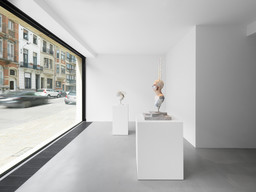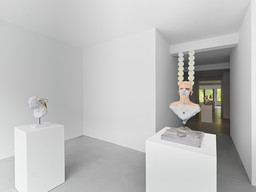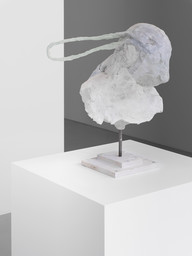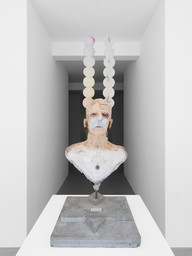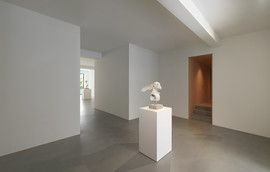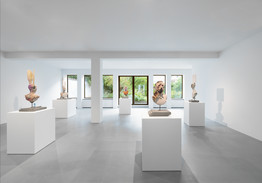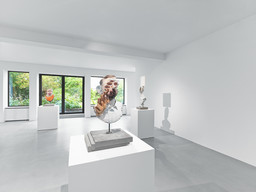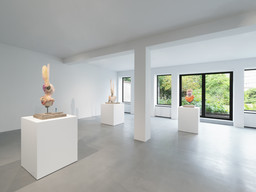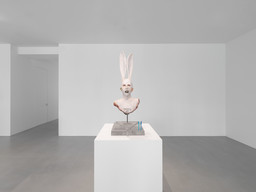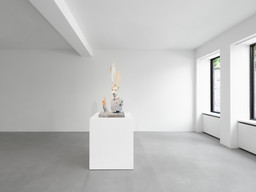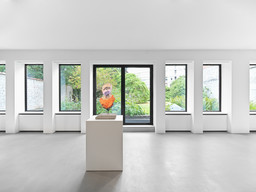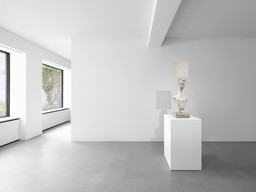David Altmejd: Rabbits
3 September—17 October 2020
44 rue Van Eyck | Van Eyckstraat
| 1 | / | 17 |
×
In this exhibition, David Altmejd presents a series of hybrid sculptures in which humans and rabbits are fused into strange and enigmatic forms. The works exemplify some of the most enduring themes in his oeuvre — transformation, metamorphosis and regeneration — while also revealing fresh creative impulses and subtle but significant shifts in his sculptural practice. Executed in a characteristically rich array of materials, including crystals, resin and fur, the anthropomorphic works are a disconcerting presence in the space: beguiling in their visual complexity yet unnerving in their other-worldliness.
While Altmejd has always been fascinated by rabbits, they have only had a discreet and subliminal presence in his oeuvre to date. In these new works, however, they manifest themselves as protagonists in their own right. Altmejd’s amalgamated forms — neither fully human nor completely animal — seem to be arrested in a state of transition that defies the laws of nature. As a result, they appear to allude to the workings of altogether more mysterious and unknowable life forces. The artist expresses the energy generated by transformation and metamorphosis, as well as by the symbiotic process of decay and regeneration, through the addition and subtraction of matter: building while deconstructing, moulding while excavating, replicating while reducing. The textural richness of Altmejd’s Rabbits, coupled with their indeterminate nature, lends them a distinctly liminal quality, as though standing on the threshold between two distinct states of being.
The works also allude to existential dichotomies such as life and death and the boundaries between, for example, science/mysticism or materiality/spirituality. As the artist explains, the works also reference different pathways towards enlightenment: Eastern Hinduism and Western Christianity. These parallel systems are represented by a number of time-honoured symbols. For example, multiple cast hands, which have previously functioned in Altmejd’s work as active tools of creation, are here raised in benediction. The circles in pale and limpid hues allude to the ancient Hindu concept of the chakras (the seven centres of spiritual power in the human body), each one of which is linked to a specific colour and vibrational tone (hence the piano keys). Multiple eyes evoke the esoteric notion of the invisible ‘third eye’ that provides perception beyond ordinary sight, while a taxonomic table references science, order and classification i.e. rationality.
The figure of the rabbit is particularly meaningful within this context as the animal has long been a symbol of fertility, desire and procreation, as well as new life, abundance, comfort and vulnerability. They are mystical creatures (associated with the resurrection in Christianity) yet integral to science (and are often used in laboratories). Adept at navigating unmarked burrows in pitch darkness, rabbits are acutely sensitive to vibrations and energies that are beyond human comprehension. For this reason, they are also linked to intuition: these creatures have no need of an outside source to illuminate the way. One only has to think of Alice in Wonderland and the journey of self-discovery that begins when the eponymous heroine tumbles down a rabbit hole…
Many of these ideas are articulated in Altmejd’s new sculptures, most notably fertility and birth. In one, the rabbit’s ears interlock in a way that is suggestive of procreation. In another, we see a drawing of a tumbling figure (an allusion to The Fall of Man?) alongside a column of luminous circles; below is a sketch of a woman giving birth. Combining sculpture and autonomous drawings is a new departure for the artist. While he has often pencilled on works before, the rabbit sculptures have now become a tabula rasa for figurative scenes relating to the human condition. If these works are about ‘being’ in terms of energy and materiality, then the drawings can perhaps be seen as corresponding to an existential awareness. Such is the significance of these vignettes that Altmejd even includes the tools of his trade in his work: pencils. Bright, vivid and upright, as though poised for use.
David Altmejd was born in Montreal in 1974 and lives and works in Los Angeles. He studied at the University of Quebec in Montreal and graduated with an MFA from Columbia University, New York in 2001. His numerous international exhibitions include The Flux and the Puddle, MNBAQ, Quebec (2016), Géants, Royal Museums of Fine Arts, Brussels (2016) and a major survey exhibition, Flux, which travelled from Musée d’Art Moderne de la Ville de Paris to the MUDAM in Luxembourg and the Musée d’Art Contemporain de Montréal, Canada (2014-15). In 2007, he represented Canada at the 52nd Venice Biennale with his installation The Index, and he was included in the Istanbul and Whitney Biennials in 2003 and 2004 respectively.
Video
Related Exhibitions

David Altmejd: L’air
4 March—9 April 2016
6 rue St-Georges | St-Jorisstraat

David Altmejd
14 February—20 March 2013
6 rue St-Georges | St-Jorisstraat
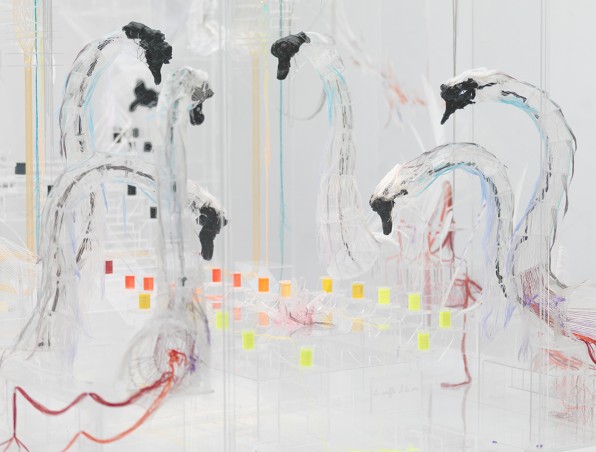
David Altmejd: Le guide
23 April—29 May 2010
6 rue St-Georges | St-Jorisstraat

David Altmejd: The Builders
24 March—23 April 2005
6 rue St-Georges | St-Jorisstraat
